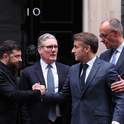Janet Yellen, who took up her position as Chair of the Federal Reserve in February 2014, gave what was probably her last official testimony in this capacity to Congress last week. She will chair just two more meetings of the Federal Open Market Committee. We will miss her, more than perhaps most people think currently. For, as I have pointed out here before, the crisis she would normally have managed will now fall to her successor, Jay Powell. He may turn out to be a competent central banker, but he’s not an economist.
Janet Yellen is a top economist, having taught at both Harvard and the LSE. She has a long list of highly-cited publications. She has been a most capable and respected head of the Fed, one of the most important institutions in the global economic system. As the first woman to hold that position, she was a trail-blazer to boot. She tolerated constructive dissent among colleagues, and had a great way with words when explaining complex economic issues. Frankly, I can’t imagine any economic adversity in which it wouldn’t be better for Dr Yellen to still be running the show.
Slow strides towards normalisation
On her watch, QE, or the regular purchase of assets by the central bank, was gradually wound down during her first 10 months, without incident or mishap.She then prepared US and global markets for a gradual shift in, or normalisation of monetary policy—the first so-called ‘tightening cycle’ in a decade. The first small rise in policy rates happened in December 2015, and when she referred to ‘gradual’, she meant it: the second didn’t happen until a year later in December 2016. Two more followed in March and June this year, and another is expected next week.
All along, Yellen has communicated her and the Fed’s thinking clearly and effectively. As the Chair of the Fed, which has a dual mandate of 2 per cent inflation and the maximum possible level of employment, she persistently emphasised the latter. The proof of the pudding is the fall in measured unemployment from 7 per cent when she took office to the current rate of around 4 per cent, which may well not be the floor yet.
She kept at bay those who wanted the Fed to tighten policy more quickly or aggressively, and constantly insisted that the central bank would be ‘data-driven’ and cognisant of ‘asymmetric risks.’ This jargon simply means that she never left any doubt that her job was to balance the risks of inadequately strong demand against the risks of resurgent inflation. It was and remains quite clear that her prejudices tilted firmly towards the former.
The proof in the fiscal pudding
Some have criticised her for sanctioning even the modest rises in interest rates that have happened, but we should remember that the signals in the economy lean her way. The economy is doing well enough, even before any possible cuts in taxation.The economy grew by over 3 per cent per annum in each of the first two quarters of 2017, and is on course to do the same in the second half of the year. Unemployment may not be falling as fast as it did, now that has reached a near trough, but further declines are likely. The stock market is at an elevated level, bond yields are rising a bit but not by much, and profits are expanding. A more assertive tightening would not be warranted, with the Fed’s main inflation indicators still well behaved, but Yellen’s policy path looks about right.
Last but not least, this summer, she floated the idea that it was time for the Fed to start unwinding the $4.5 trillion balance sheet it had accumulated—that’s basically asset purchases under the QE programmes. The idea was confirmed in September and is now underway. Again, this has been done without market disturbances or economic disruption at home or abroad.
In her testimony last week, she again justified the case for gradual increases in interest rates so as to keep risk of boom-bust in the economy at arm’s length, but she also warned lawmakers about the need to contain the budget deficit over the longer-term.
She at least knows the risks that they will take if they pass unfunded tax cuts demanded by the White House and Congressional Republicans, which could lose up to $1.5 trillion in tax revenues over the next decade. Similarly, her pitch for ‘equity’ in the tax code so as to address income inequality, and the need for steady Federal funding of education, infrastructure and innovation.
The coming crisis
Quite why President Trump didn’t offer her a second term is unknown. Probably because vanity required he appoint his own people, and perhaps because Yellen would be no one’s patsy.In any event, Yellen, who could have stayed on as a governor for another decade, has decided to leave. Among the 7-person Federal Reserve Board, Powell will be new, and Trump will have to fill 3 other Board vacancies, including the Vice Chair.
The hawk-dove mix among policy-makers may change but with Yellen’s departure, along with that of Stan Fischer the previous Vice Chair, and Bill Dudley of the New York Fed, who is Vice Chair of the Open Market Committee, the central bank is at least going to lose depth and experience.
Yellen’s term was too short for a crisis, but in that she was fortunate. Every Fed Chair has had a crisis.
Arthur Burns (1970-78) ran the Fed during a turbulent period in the US, in which crisis was the rule, rather than the exception. But Richard Nixon appointed him, specifically because he wanted a compliant Fed, and Burns’ poor record speaks for itself. Paul Volcker (1979-87) had to deal immediately with the inflation crisis, and he also had one deep recession, and then the savings and loan crisis. Alan Greenspan (1987-2006) had the 1987 stock market meltdown very soon on his watch, and over two decades, he had two recessions, the Asia crisis and the tech bubble. Ben Bernanke had the financial crisis and the deepest recession since the 1930s.
Yellen’s crisis will now be Powell’s. We don't know whether it will emerge from a rise in inflation finally, income inequality or other economic or financial issues at home or overseas.
It could be the tax cutting programme that the Senate approved last week and that now has to be reconciled with the House version before getting the President's signature. With the economy growing well over 3 per cent this year, it doesn't need an unfunded and inequitable fiscal stimulus that will boost public debt by over $1.5 trillion, and yet that's precisely what the Congress and the President desire. If the Fed should want to raise interest rates faster because of it, they have only themselves to blame.
Yet, if that happens, the risk of an economic downturn would rise too, and the Fed’s response would then become crucial given the limited interest rate cutting ammunition in the policy arsenal. I already wish Janet were there when this looms into view.












